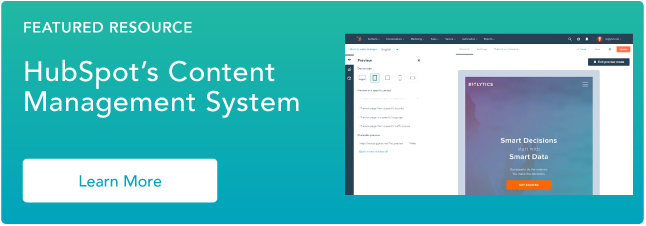When I want to create an online presence that will help my business get found by prospects on Google and other search engines, securing a domain or domain name is the first step I take.

In this post, I’ll cover everything you need to know about what a domain means, how it’s different from a URL, and so on. That way, you’re not entirely clueless when setting up your business website.
Table of Contents
- What is a domain?
- Domain Name vs. URL
- What Does a Domain Look Like?
- Internet Domain vs. Network Domain
- Who manages domain names?
- What are domains used for?
- What is a domain name?
- Types of Domains
- Setting Up Your Domain
What is a domain?
A domain is a part of the web address nomenclature someone would use to find your website or a page of your website online. It is a string of text associated with the numerical IP address of a website that's much easier for people to remember and search.
Every website has an Internet Protocol (lP) address, a unique string of numbers that connects computers to web servers. IP addresses are great for computers but difficult for people to memorize. I wouldn’t be able to remember a string of randomly generated numbers. That's where domains come in.
A domain name is connected to a website's IP address so people can more easily remember and search for a website by its domain. Their browser can still find the specific web server that hosts the website via the associated IP address.
I think of my website domain like my home address. My friends don’t memorize my house’s GPS coordinates whenever they want to visit me. Instead, they just plug my street address into their phones. The same goes for visiting a website. Instead of memorizing a website’s IP address, visitors simply type in the domain into their browser.
For example, in the web address “google.com,” “google” is the domain name, while “142.250.184.196” is the IP address computers use to connect websites and the internet.

Domain Name vs. URL
Your domain name is like your house address, while the Uniform Resource Locator (URL) is like the full address that includes details like your street name, zip code, state, etc. A domain name is part of what makes up a URL. Meanwhile, the URL is your entire web address.
What Does a Domain Look Like?
A domain typically consists of two or three words separated by dots. For example, blog.hubspot.com is a domain.
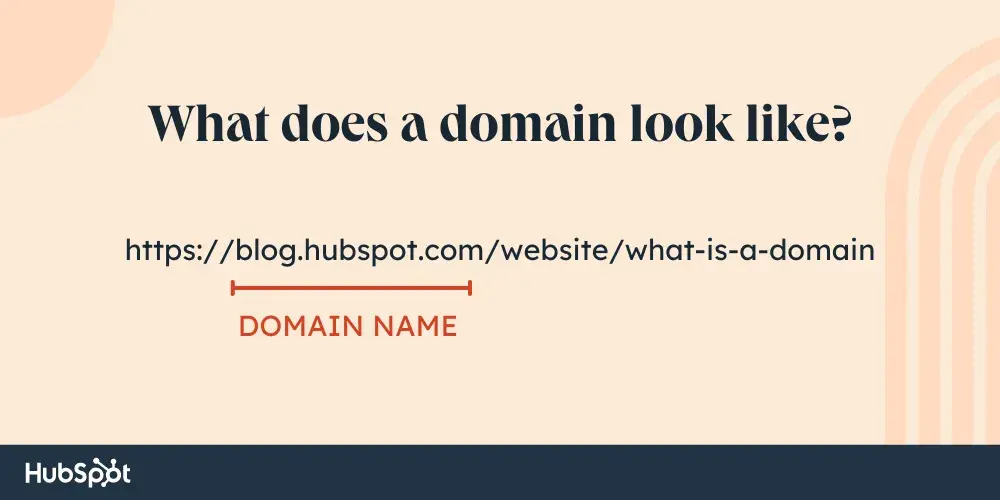
A domain is one part of a complete web address or URL. A URL typically consists of a protocol, domain name, and path. For example, the URL of this blog post is https://blog.hubspot.com/service/what-is-a-domain. It's made up of the following parts:
- protocol (“https://”)
- domain name (“blog.hubspot.com”), which consists of a subdomain (“blog.”), a second-level domain (“hubspot”), and a top-level domain (“.com”)
- subdirectory (“/website/”)
- path (“/what-is-a-domain”)
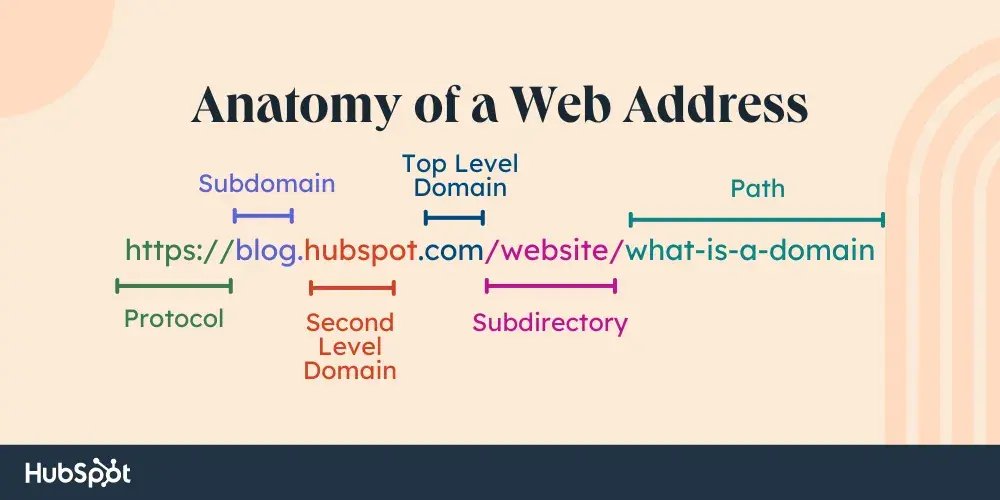
Internet Domain vs. Network Domain
An internet domain is a readable name that identifies a website. For instance, “hubSpot,” “google,” etc. It is this domain I’m talking about throughout this article.
When I want to look up something on HubSpot’s website, I type in “hubspot.com” instead of a bunch of numbers because I know HubSpot’s internet domain name.
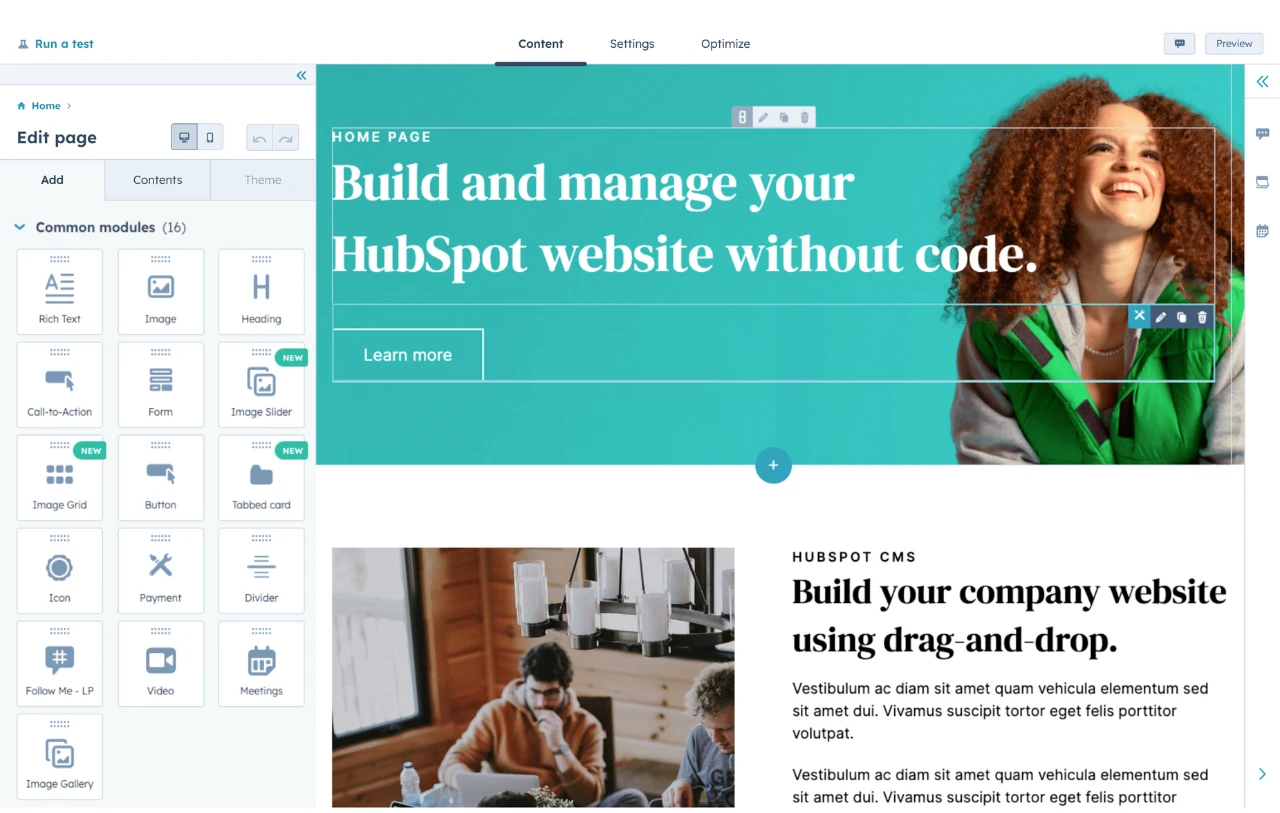
HubSpot's Free Website Builder
Create and customize your own business website with an easy drag-and-drop website builder.
- Build a website without any coding skills.
- Pre-built themes and templates.
- Built-in marketing tools and features.
- And more!
The Domain Name System (DNS) translates internet domain names to IP addresses so browsers can locate web pages. On the other hand, a network domain describes a group of interconnected devices like desktops, printers, and servers sharing the same purpose.
An administrator is typically in charge of managing the devices within this network. Users in a network domain can communicate with each other but often have different access levels depending on their role or position in the organization.
Who manages domain names?
Several organizations are involved in managing domain names. At the top of the hierarchy are organizations like the Internet Assigned Numbers Authority (IANA) and Internet Corporation for Assigned Names and Numbers (ICANN).
These bodies manage policies around domain name registrations, accredit domain name registries, and oversee the DNS. They typically do not interact directly with the public.
Domain name registrars are companies people are more familiar with. These registrars allow you to register unassigned or available domains for a fee.
Let's cover why domains are essential.
What are domains used for?
Domains are not only used to simplify how visitors find your website. Below, I’ll look at several other reasons domains are used.
1. Gaining Ownership
Perhaps most importantly, a domain gives me ownership over my website's address. No one else can claim it while I have it registered. That can be helpful if the domain is my business’ or my unique name. I’m basically reserving internet real estate.
This grants me total control over what website it points to, which domain name registrar maintains it, what information is associated with my domain name account, who administers it, and whether I want to sell it.
2. Solidifying Brand Identity
A domain name that matches or resembles my company name can help me establish a consistent online brand identity. For example, a visitor moving from my website’s homepage to my blog to my knowledge base will notice that the core domain name remains consistent. This reinforces other consistent elements, like the color scheme and typography.
3. Establishing Credibility
A domain name that aligns with my company name establishes credibility and makes my website appear more legitimate and professional to users. That builds trust with my visitors so they feel comfortable taking action, like submitting a survey or form on a web page with that same domain name.
Some website builders will provide a templated subdomain to free users, such as accountname.wixsite.com/address. However, a custom website with a custom domain name, such as accountname.com, may seem more credible and professional to incoming visitors!
When I’m looking at a freelancer portfolio, for example, a .wixsite makes me think they’re a hobbyist. A custom domain name shows me that they’re a professional who has invested in their digital presence.
4. Being Memorable
If my domain is easy to remember, visitors can quickly enter it into their search bars — resulting in more direct traffic to my site. For example, T-Bones Great American Eatery has a short and sweet domain name: t-bones.com. This domain name is much easier to remember than an alternative like t-bonesgreatamericaneatery.com.
5. Standing Out Against Competitors
A simple but catchy domain name distinguishes my site from competing sites with clunkier or confusing domains. For example, if Google had been named BackRub, it might not have competed as well with Yahoo and other search engines.
6. Building Authority
In addition to strengthening a brand, domain names can help predict how likely my website is to appear in the SERPs compared to my competitors. As a rule of thumb, the older a domain is, the more authority it has. That’s because it’s had time to accumulate quality content, internal links, and backlinks.
What is a domain name?
A domain name is the unique name of a website. It functions like the site‘s home address on the World Wide Web. The term “domain name” is used interchangeably with "domain." The only difference is that one is the thing’s name, and the other is the thing itself.
Not including its extension, like “.com”, the maximum length of a domain name is 63 characters. The minimum length can be one character.
For a quick overview of what a domain name is and what it's made of, check out this video by Elegant Themes.
[Video: Everything You Need to Know About Domain Names]
The Parts of a Domain Name
A domain typically has two parts: the second-level and the top-level. If read left-to-right, these parts decrease in specificity.
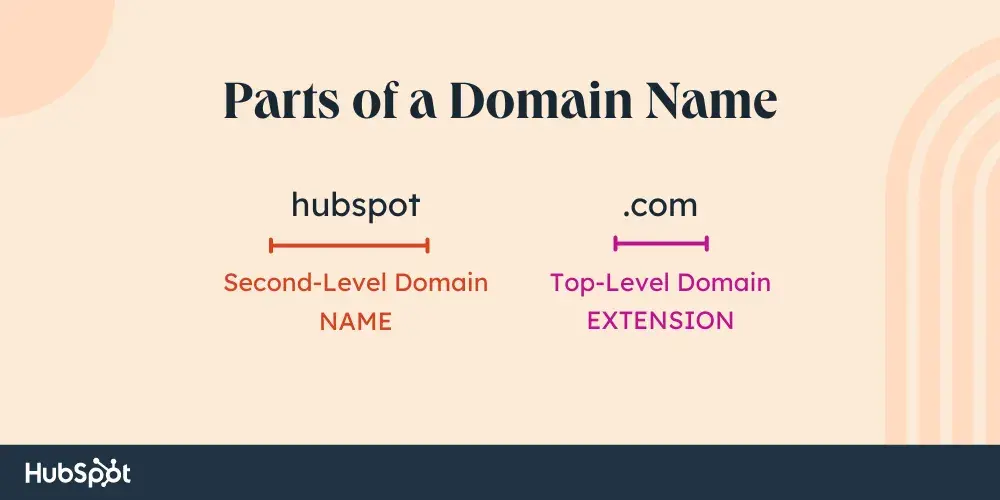
Second-Level Domain (SLD)
The second-level domain is the unique identifier for your website. It's the part of your domain that comes before “.com” or another extension.
If I’m building a website for my business, I want to buy a domain that reflects my business's name. This will make it easier for people to find your website without spending too much time searching Google for it. For instance, hubspot.com’s second-level domain is “hubspot.”
Top-Level Domain (TLD)
The top-level domain is the extension or the part of your domain that comes after your second-level domain.
It specifies what type of entity your organization registers as on the internet. For example, HubSpot’s top-level domain is “.com” since we’re a commercial entity in the United States.
Most American businesses also register their website with “.com.” In fact, according to data from Verisign, the largest TLD in 2023 was .com, with 159.6 million reported domain names in the domain name base.
What is a domain name example?
An example of a domain name is usps.com. This is made up of a second-level domain (“usps”) and a top-level domain (".com). It is one of the most visited government domain names, according to Statista.
Other examples of popular domain names are “youtube.com”, “irs.gov”, and “tiktok.com.” Check out more in the list below:
These are just a few domain name examples — there are literally millions more. According to data from Verisign, there were over 359.8 million registered domain names at the end of 2023.
To better understand possible domain names, let's look at the different types of domains below.
Types of Domains
- Generic Top-Level Domains (gTLD)
- Country Code Top-Level Domains (ccTLD)
- Internationalized Country Code Top-Level Domains (IDN ccTLD)
- Subdomain
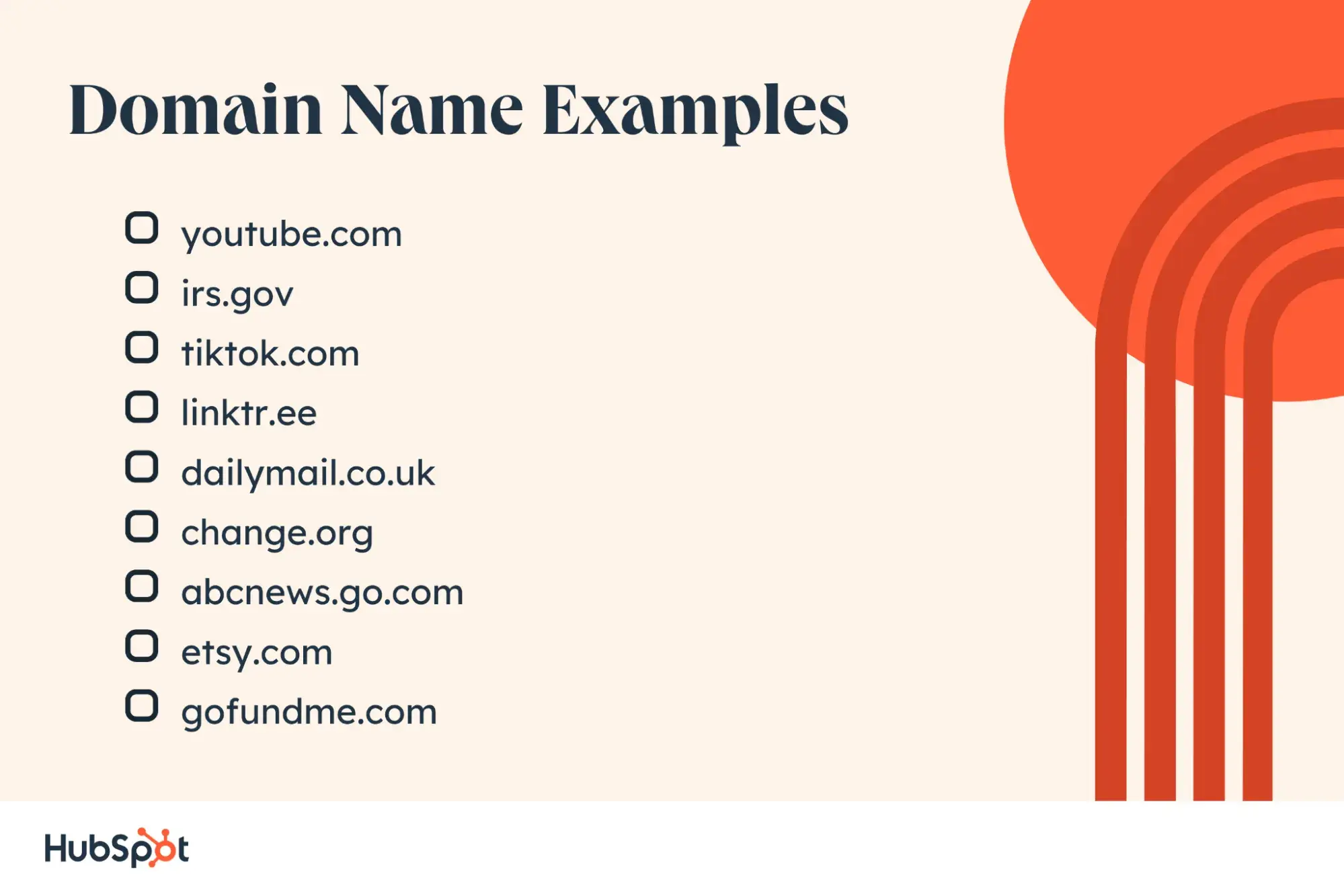
Generic Top-Level Domains (gTLD)
gTLD refers to the best-known and most broadly used TLDs:
- .com
- .net
- .biz
- .org
- .info
Today, .com is the most popular by far. As of December 2023, 46% of global websites used a .com top-level domain. The next most popular — .ru — is only used by 5%.
Country Code Top-Level Domains (ccTLD)
These two-letter TLDs refer to specific geographical locations. Here are the most common ones:
- .cn (China)
- .ru (Russia)
- .de (Germany)
- .br (Brazil)
- .au (Australia)
- .uk (United Kingdom)
- .nl (Netherlands)
Internationalized Country Code Top-Level Domains (IDN ccTLD)
These are domains that can be displayed in non-Latin character sets (e.g., Chinese).
Subdomain
A subdomain is a domain that is part of a larger domain, appearing before the root domain name (e.g., blog.hubspot.com). Since a subdomain appears to the left of the SLD, it is also referred to as a third-level domain (3LD).
Another example of a domain name with a subdomain is tools.usps.com. It is made up of a subdomain (“tools.”), a second-level domain (“usps”), and a top-level domain (".com”).
You may already be familiar with this domain name. In March 2022, it was the most popular government domain, getting over 244 million visits in 30 days, according to Statista.
Now that you know what a domain is, you're ready to register one. Check out the step-by-step process in Everything You Need to Know about Custom Domains.
Pro tip: Content Hub users can add their custom domain to HubSpot for free. This allows you to connect your new domain to hosting, CDN, and security features all at one time.

HubSpot's Free Website Builder
Create and customize your own business website with an easy drag-and-drop website builder.
- Build a website without any coding skills.
- Pre-built themes and templates.
- Built-in marketing tools and features.
- And more!
Setting Up Your Domain
If I want to acquire a domain name, I need to buy and register one. To do this, I can visit a domain name registrar, like GoDaddy or Google Domains. I can then plug in my desired domain name, check its availability and price, and then buy it, if it’s in my price range.
From there, I can associate that domain with your server and hosting provider, making my site accessible via the web address.
What’s in a name?
When it comes to finding the right domain name, availability isn’t the only factor that matters. I need to choose a name that’s easy to remember and in line with my brand. In the best-case scenario, the domain name that matches my business is available. If not, I need to come up with something close that’s still catchy.
If you’re stuck or torn between a few options, ask for your friend’s opinion. They’re netizens whose opinions can help you move in the right direction. Now, go off and register that domain!
Editor's note: This post was originally published in February 2019 and has been updated for comprehensiveness.

